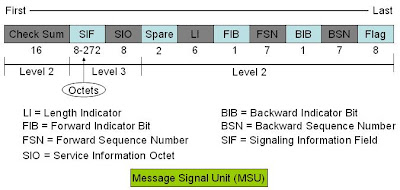Different types of Signaling Units used in SS7 Protocols are: -
- FISU - Fill-In Signal Unit
- LSSU - Link Status Signal Unit.
- MSU - Message Signal Unit
FISU - Its a lowest Level Signal Unit, Its generated automatically in both directions on all links as traffic volume decreases. It Provides continuous Error Checking on signaling links when there are no MSUs. It allows SS7 network to maintain its reliability. It contains basic level 2 information only i.e. acknowledgment of signal unit receipt by a remote signaling point.
- Check Sum - It is calculated from the transmitted message by the transmitting signaling point & inserted in the message. On receipt it is recalculated by receiving signaling point. If not the same, the message is corrupt & retransmission is requested.
- Spare - Used as a filler since the LI only uses 6 of the possible 8 bits.
- LI - Indicates length of Signaling Unit (SU). FISU LI=0, LSSU LI=1 or 2, MSU LI=3 to 63. If MSU is larger than 63 octets (bytes) it will not be indicted, max.273 octets.
- FIB - Used in error recovery like BIB, When messages are transmitted in error, & the BIB has changed from 1 to 0 or 0 to 1, the FIB will change to match the BIB, when corrupted messages have been successfully retransmitted. If there are no error message, BIB & FIB will have the same value 0 or 1.
- FSN - Contained the sequence number of a transmitted SU, can be between 0-127, or 128 possible SUs in transmit buffer.
- BIB - Indicates the negative acknowledgment, if the bit does not match the FIB bit value, either 0 or 1.
- BSN - Used to confirm the receipt of SUs & to ensure they are received in the order they were transmitted. The BSN value will match that of the last successfully received SUs FSN. Value can be 0-127 or 128 possible SUs in received buffer.
- Flag - It act as a delimiter for SUs. A flag marks the end of the SU & the start of the next SU, Always looks like 01111110.
LSSU - It is used to control Link Alignment. It contains one or two octets of link status information. It indicates the status of a signaling point (e.g. local processor outage) to the remote signaling point.
It has one unique field, the Status Field (SF). The SF can have any one of the six different status indications, those are.
- Busy (SIB) - Level 2 is busy, or congested at transmitting signaling point(SP). A SP will suspend MSUs when it receives a busy LSSU. If the condition lasts 3-6 sec, Level 3 will be informed of a link failure & begin alignment process.
- Processor Outage (SIPO) - Transmitting signaling point cannot communicate with Level 3 & 4, possible due to a CPU or total nodal failure. or being manually taken out of service with the canc-slk command.
- Out of Service (SIOS) - SP cannot transmit or receives any MSUs for the reason other than processor outage. Upon receipt of an SIOS the receiving SP stops the transmission of MSUs & begin transmitting FISUs. It is also sent at the beginning of the alignment process.
- Out of Alignment (SIO) - Sent when a link has failed, is restored & alignment procedure has been initiated, but proving period parameters have not been met.
- Normal Alignment (SIN) - Procedure used when there is more than one SLK in the affected linkset. During the alignment process, the slk is looking for 4 successfull normal alignment LSSUs in a 2.3sec. proving period, if it fails it goes out of alignment again.
- Emergency Alignment (SIE) - Procedure used when there is only 1 slk in a linkset. During the alignment process, the slk is looking for 1 successful emergency alignment LSSU in a 0.6sec. proving period.
MSU - It is used for Call Control, Database query & response, Network Management, Network Maintenance, Routing Labels which consists of an Origination & a Destination point Code.
It provides the structure for transmitting all messages types such as ISUP, TUP, TCAP, MAP.
It has 2 unique fields -
- Service Information Octet (SIO) - It tells level 4 the type of service requested & the type of network message, & the priority of the MSU.
- Value 0 - indicates a signaling network management message.
- Value 1 - indicates a signaling network test & maintenance message.
- Value 2 - indicates a special signaling network test & maintenance message.
- Value 3 - indicates a SCCP message.
- Value 4 - indicates a TUP message.
- Value 5 - indicates a ISUP message.
- Value 0 - indicates an International Network.
- Value 1 - indicates a National Network.
Message priority values are from 0-3
- Value 0 - indicates Lowest Priority Message.
- Value 3 - indicates Highest Priority Message.
- The Routing Label of the message (OPC / DPC).
- A Signaling Link Selector (SLS), used to distribute traffic over multiple signaling links within a linkset if available.
More Information from Readers are Expected !!!
Thanks
telecomtigers@gmail.com
http://homepageforu.webs.com/














No comments:
Post a Comment